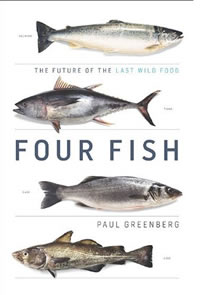Book Notes
 Paul Greenberg, Four Fish; The Future of the Last Wild Food (New York: The Penguin Press, 2010), 284pp.
Paul Greenberg, Four Fish; The Future of the Last Wild Food (New York: The Penguin Press, 2010), 284pp.
Paul Greenberg fell in love with fishing as a youngster. As an adult he's written a book that's not only a pleasure to read but important to consider when it comes to the ethics of eating. He takes us with him on his journalistic travels, from the Norwegian North Atlantic to the New Zealand Pacific, from the frigid waters of Russia and Alaska to the sweltering heat of the Mekong Delta, Israel, and Greece. Everywhere he traveled, says Greenberg, the empirical evidence is unequivocal — increased consumer demand for fish (170 billion pounds of wild fish every year) is putting tremendous pressure on a fragile and limited supply.
Greenberg structures his book around four fish that he calls "archetypes" or "archives" of fish as food: salmon, sea bass, cod, and tuna. But he also considers many more, like carp, hoki, pollock, tra, tilapia, swordfish and whales. Greenberg pushes the discussion of fish beyond the binary opposition between good-wild-fresh or bad-artificial-farmed, beyond the notion that individual consumer choice will make much difference, and into the areas of ambiguities, trade-offs, and ambivalence about a complex problem.
Wild fish like the blue fin tuna face serious threats of depletion and even extinction. In 1994 the federal government closed New England's Georges Bank fishing grounds to commercial fishing. Pacific salmon face extinction in forty percent of the rivers where they once thrived in the American west, and in the entire Atlantic Ocean salmon have plummeted from a population of many millions to about five hundred thousand. But Greenberg is not an unremitting pessimist about wild fish, and he's happy to report success stories and to give credit where it is due. Today when you think of a whale, for example, you think "animal" and not "food." Some depleted wild species have shown remarkable abilities to rebound and replenish. We should enjoy wild fish, but also know what we're doing.
Farmed or domesticated fish are necessary, in Greenberg's view. He's optimistic that the Vietnamese tra and the African tilapia might be reasonable substitutes for our "industrial" cod. But domesticated fish present many challenges beyond taste and texture. Environmental constraints, the manipulation of fish DNA, escapees, privatization, monopolies, industrialization, and market forces all come into play. There's also the matter of marine protein inputs and outputs; does it make sense to use five pounds of fish feed to produce one pound of farmed food? The production of farm-raised sea bass has been so successful that about 180 million pounds are produced a year, compared to 10 million pounds of the wild version. But this abundance has collapsed profit margins from about ten dollars per pound to 1/4 of a cent per pound. So, farmed fish is necessary but problematic.
Greenberg argues that we need both wild and farmed fish. But inherent conflicts of interest and tradeoffs abound between scientists, fishermen, governments, regulatory agencies, international boundaries and treaties, lobbyists, multi-national corporations, and consumers. In the last pages of his book he thus proposes a handful of suggestions to guide the future of both wild and farmed fish. We need significant reforms in both areas, he says, because, although it's a worthy choice to stop eating sushi, the scale and complexity of the problems are far too big for that to make much of a difference for the future of fish.

